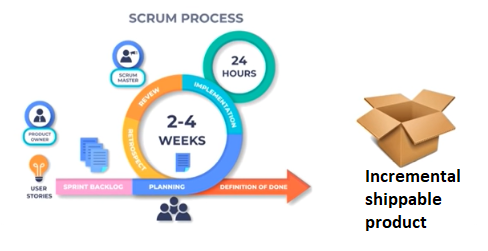Difference between Scrum and Kanban
Scrum and Kanban both are agile frameworks and follow agile principles and methodologies. They both use a pull system where the work is pulled from a workflow if there is a demand for it.
They both break down the larger work (requirement) into smaller tasks and goals.
The key differences lie in terms of:
-Processes
-Team structure
-Roles and Responsibilities
-Release Methodology
-KPI
-Application
Scrum
In scrum, the deliverables are divided into sprints. Each sprint has a predefined timeline, typically 2 to 4 weeks.
After the end of each sprint, the outcome is a shippable product.
Each sprint begins with a sprint planning phase and
the deliverable or the goal of the sprint is pre-defined at the beginning of the sprint during sprint planning.
In scrum, no story can be added in the middle of the ongoing sprint. i.e Adding new work is not allowed in the middle of an ongoing sprint.
At the end of every sprint, a viable feature is released, and the next sprint follows immediately.
The scrum teams are cross-functional. A clear
role and responsibilities are defined like - scrum master, product owner, development team, etc.
Followed by daily standup and the timelines are defined for each sprint in the scrum.
Productivity can be measured in terms of velocity through sprints.
It is the number of story points completed during a sprint.
Best for the projects having stable priorities. It is more structured and focused on delivering a set goal at the end of each sprint.

Kanban
Kanban is an agile framework that is focused on continuous task flow and continuous delivery. In Kanban, there is no predefined timebox for the tasks. The tasks are allotted on the basis of capacity and there is a limit to the Work in progress (WIP). In kanban, a new requirement can be added or removed in the middle of the development cycle. The kanban teams are specialized. Roles are not clearly defined. Although the agile coach is there. The focus is on continuous task flow and continuous delivery. Just in time planning, unlike scrum where the sprint planning happens at the beginning of the sprint for a relatively bigger time period. Productivity can be measured in terms of cycle time or the amount of time it took to complete a full piece of a project. Best for the projects having widely varying priorities. It is more flexible.

Scrum vs Kanban
| Scrum | Kanban | |
|---|---|---|
| Release Methodology | Deliverables are divided into sprints | Based on continuous flow of tasks and continuous delivery |
| A shippable product is an outcome of a sprint | Continuous development of feature happens | |
| Planning | Each sprint is well planned and well defined in advance | Only just in time planning happens |
| Modification | A new requirement cannot be added in an ongoing sprint | A new requirement can be added or removed from development cycle |
| Storyboard | A new scrum board for every sprint | Same Kanban board continues as long as project continues |
| Team | The scrum teams are cross-functional | The kanban teams are specialized |
| Roles | Role and responsibilities are clearly defined like - scrum master, product owner, development team | Roles are not clearly defined |
| KPI | Productivity can be measured in terms of velocity i.e. the number of story points completed during a sprint | Productivity can be measured in terms of cycle time or the amount of time it took to complete a full piece of a project |
| Application | Best for the projects having stable priorities | Best for the projects having widely varying priorities |
